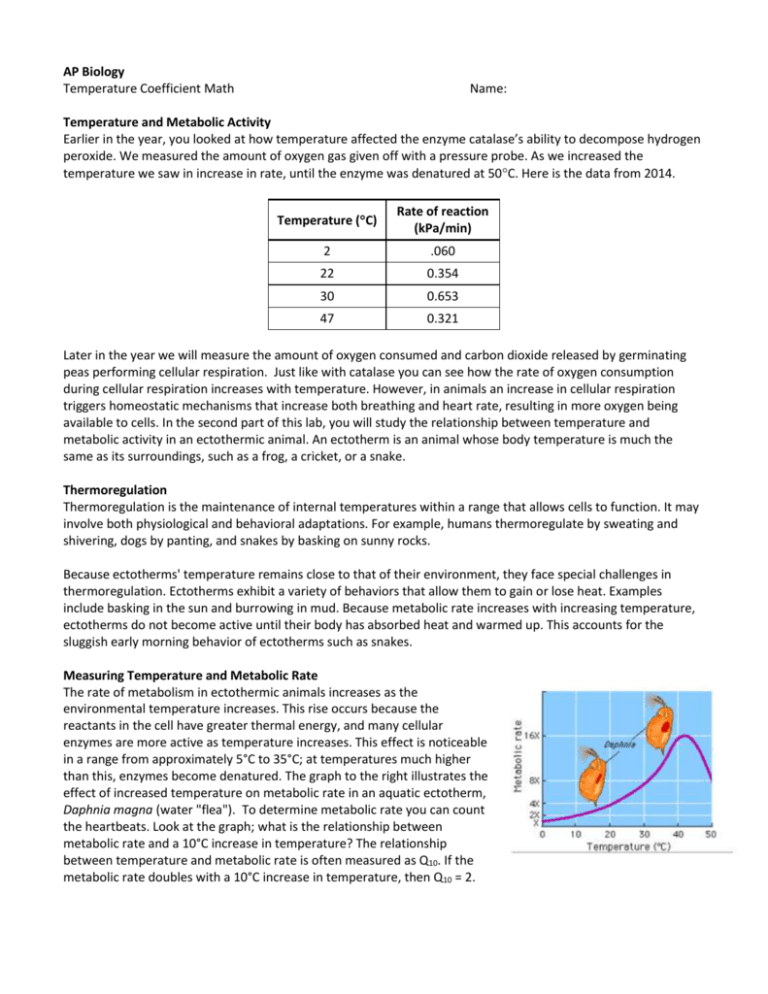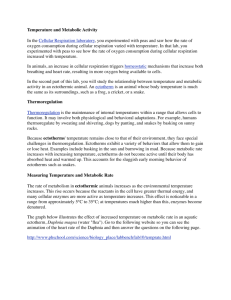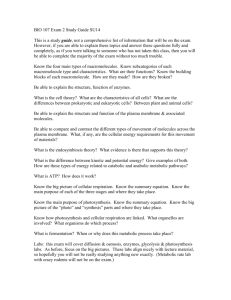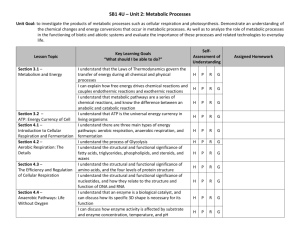Homework 3 on Q10 Math
advertisement

AP Biology Temperature Coefficient Math Name: Temperature and Metabolic Activity Earlier in the year, you looked at how temperature affected the enzyme catalase’s ability to decompose hydrogen peroxide. We measured the amount of oxygen gas given off with a pressure probe. As we increased the temperature we saw in increase in rate, until the enzyme was denatured at 50C. Here is the data from 2014. Temperature (C) Rate of reaction (kPa/min) 2 .060 22 0.354 30 0.653 47 0.321 Later in the year we will measure the amount of oxygen consumed and carbon dioxide released by germinating peas performing cellular respiration. Just like with catalase you can see how the rate of oxygen consumption during cellular respiration increases with temperature. However, in animals an increase in cellular respiration triggers homeostatic mechanisms that increase both breathing and heart rate, resulting in more oxygen being available to cells. In the second part of this lab, you will study the relationship between temperature and metabolic activity in an ectothermic animal. An ectotherm is an animal whose body temperature is much the same as its surroundings, such as a frog, a cricket, or a snake. Thermoregulation Thermoregulation is the maintenance of internal temperatures within a range that allows cells to function. It may involve both physiological and behavioral adaptations. For example, humans thermoregulate by sweating and shivering, dogs by panting, and snakes by basking on sunny rocks. Because ectotherms' temperature remains close to that of their environment, they face special challenges in thermoregulation. Ectotherms exhibit a variety of behaviors that allow them to gain or lose heat. Examples include basking in the sun and burrowing in mud. Because metabolic rate increases with increasing temperature, ectotherms do not become active until their body has absorbed heat and warmed up. This accounts for the sluggish early morning behavior of ectotherms such as snakes. Measuring Temperature and Metabolic Rate The rate of metabolism in ectothermic animals increases as the environmental temperature increases. This rise occurs because the reactants in the cell have greater thermal energy, and many cellular enzymes are more active as temperature increases. This effect is noticeable in a range from approximately 5°C to 35°C; at temperatures much higher than this, enzymes become denatured. The graph to the right illustrates the effect of increased temperature on metabolic rate in an aquatic ectotherm, Daphnia magna (water "flea"). To determine metabolic rate you can count the heartbeats. Look at the graph; what is the relationship between metabolic rate and a 10°C increase in temperature? The relationship between temperature and metabolic rate is often measured as Q10. If the metabolic rate doubles with a 10°C increase in temperature, then Q10 = 2. 𝑄10 10⁄ (𝑇2 −𝑇1 ) 𝑅2 =( ) 𝑅1 Practice Questions 1. The data in the table below was taken to determine the effect of temperature on the rate of respiration in a goldfish. Calculate the Q10 for this data. Round to the nearest whole number. Temperature (°C) 16 21 Respiration Rate (breaths/min) 16 22 2. Which of the following organisms would show the greatest fluctuation in body temperature hour by hour? a. Dolphin b. Mouse c. Lake trout d. Rattlesnake 3. Explain your answer to question 2. 4. Look at the graph on page one. What is the relationship between metabolic rate and body temperature in Daphnia? a. As the body temperature increases, the metabolic rate decreases. b. An increase of 10°C results in a doubling of metabolic rate. c. Heart rate increases as body temperature decreases. d. Cellular enzymes are less active at 35°C than at 20°C, resulting in decreased metabolic rate. 5. If Q10 = 2, then an enzymatic reaction that takes place at a given rate at 5°C would take place approximately how many times faster at 25°C? a. Twenty times b. Eight times c. Four times d. Three times e. Two times 6. Which of the following experimental conditions would be most life-threatening for an ectothermic organism? a. Temperatures that exceed 40°C b. Temperatures that are between 3°C and 8°C 7. Explain your answer to 6.







